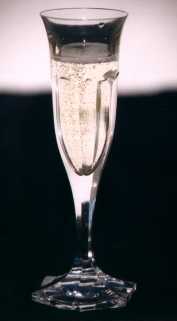The ideal temperature at which to store wine is between 9-14°C. Slightly lower or even higher temperatures are not so dangerous for the wine as is the variation from one extreme to another. Unfortunately not everyone owns a wine cellar or Eurocave-type refrigerator with different compartments at various temperatures suitable to each type of wine. For those wine lovers without a proper cellar, such as those found at most older houses in Prague (a panelák cellar is unsuitable, as these are usually centrally heated), it is possible to make do with an understairs cupboard or the bottom of a wardrobe in the bedroom, where the temperature is usually lower than in the living quarters. These days there are numerous wine shops and merchants around the country who provide cellaring services for their customers. Wines are best stored in a horizontal position in order that corks do not dry out so letting in bacteria that would spoil the wine. It is adviseable to check the capsules of the bottles from time to time for any leakages, which would be a sign of this happening. Labels should face upwards, in order to identify the bottles easily and also so that one will know that any sediment will lie on the opposite side of the bottle. A cellar book should be kept in which details of stock, such as dates and prices of bottles purchased along with their respective tasting notes are entered. If wine is stored on racks, white wines should be kept on the bottom, where the temperatures are the coolest, red wines in the middle with sherries and ports on the top. Wine can also be decanted and this is done for various reasons. Most often it is carried out to get rid of the sediment which has precipitated after a long maturation in bottle. Another reason is to let the wine "breathe", although nowadays this is considered to be something of a myth. The truth is, that by the action of being poured from the bottle to a glass, it will have had enough time to become aerated. Other good reasons for decanting are blind tastings, competitions or exams, where wines are tasted anonymously - partially specified or unspecified. For instance, a skilled taster could recognise a shape of a bottle used in a specific wine region and so on (e.g. Bordeaux, Burgundy, Alsace flute, green-coloured glass for Mosel or brown for Rhein etc.) and by decanting the wines, any hints of this sort would be avoided. Generally though, only old wines such as Vintage Port or corpulent clarets, Australian Shiraz or those red wines that underwent a considerable period of ageing in bottle have to be decanted. The bottle is placed upright for 24 hours before serving, in order that the sediment falls to the bottom. The cork should be pulled with a minimal movement of the bottle and the contents carefully emptied into a decanter. Sometimes a flame of a candle is used in order to see the sediment as it approaches the neck of the bottle. When the wine starts to become cloudy, the decanting process should cease.  The choice of a glass is also often overlooked. Champagne and sparkling wine should be served in a tall flute-shaped glass and not in the saucers, referred to as Marie-Antoinette's breasts, that are better used for serving ice-cream sundaes. From such large flat glasses the sparkle quickly disappears and the bubbles evaporate. It is a shame to be deprived of this exhilarating experience after popping a cork from a bottle of fine fizz. Sherry is traditionally served in a glass called a copita, from which it is also possible to enjoy Port. It is a smaller type of the INAO/ISO tasting glass. White as well as red wine is perfectly enjoyed from a glass in which we can see the colour and smell the nose. The best is a tulip-shaped clear glass that helps concentrate the aroma. Wine enthusiasts also love to swirl the wine in the glass in order to appreciate its bouquet, therefore it is advisable not to fill the glass to the rim. Needless to say, all glasses should be clean. Any residue from the detergent or washing-up liquid instantly kills the bubbles in sparkling wine, therefore it is recommended to rinse them in hot water before polishing. The choice of a glass is also often overlooked. Champagne and sparkling wine should be served in a tall flute-shaped glass and not in the saucers, referred to as Marie-Antoinette's breasts, that are better used for serving ice-cream sundaes. From such large flat glasses the sparkle quickly disappears and the bubbles evaporate. It is a shame to be deprived of this exhilarating experience after popping a cork from a bottle of fine fizz. Sherry is traditionally served in a glass called a copita, from which it is also possible to enjoy Port. It is a smaller type of the INAO/ISO tasting glass. White as well as red wine is perfectly enjoyed from a glass in which we can see the colour and smell the nose. The best is a tulip-shaped clear glass that helps concentrate the aroma. Wine enthusiasts also love to swirl the wine in the glass in order to appreciate its bouquet, therefore it is advisable not to fill the glass to the rim. Needless to say, all glasses should be clean. Any residue from the detergent or washing-up liquid instantly kills the bubbles in sparkling wine, therefore it is recommended to rinse them in hot water before polishing.
Finally, have you come across the term "vertical" or even "horizontal" tasting and were embarrassed to ask whether this is undertaken while standing, sitting down or even lying down? A vertical tasting means that different vintages from one producer or château are being presented, whilst a horizontal tasting deals with different wines from various producers in any one region but of the same vintage.
|








